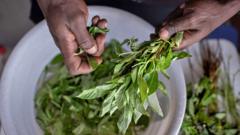Kenyans are embracing indigenous vegetables, with restaurants prioritizing 'kienyeji' greens on their menus, reflecting a growing appetite for nutrient-rich local produce.
### Culinary Revival: Indigenous Vegetables Make a Comeback in Kenya

### Culinary Revival: Indigenous Vegetables Make a Comeback in Kenya
The resurgence of traditional leafy vegetables in Kenya highlights the nation's culinary and agricultural evolution, transforming once-overlooked crops into sought-after dishes.
As awareness surges, indigenous vegetables like managu and mrenda are gaining prominence, challenging the dominance of introduced crops like cabbage and kale in Kenyan diets.
In Kenya, culinary trends are shifting as once-dismissed indigenous leafy vegetables, dubbed "kienyeji," are gaining popularity on plates across the nation. Historically categorized as "poor man's food" or wild weeds, these nutrient-dense crops are now celebrated for their health benefits and superior flavor, contributing to a renewed interest in local agricultural practices.
At the bustling Skinners Restaurant in Gachie, near Nairobi, staff report an increasing demand for kienyeji greens, despite the fact that they often come at a premium due to their regional rarity. This demand reflects a broader cultural shift, where Kenyans are reconsidering their relationship with traditionally cultivated crops. Horticulture professor Mary Abukutsa-Onyango notes the significant growth in production of these indigenous vegetables, with annual outputs rising to 300,000 tonnes, effectively doubling over the past decade.
Local varieties, such as managu (African nightshade) and mrenda (jute mallow), boast higher nutritional profiles with essential vitamins and antioxidants, outperforming their more prominent counterparts like cabbage. The growing appreciation for these greens marks a profound change in societal attitudes, as many now seek organic options that are more resilient to pests and diseases.
Emblematic of this transformation is the story of Francis Ngiri, a farmer advocating for organic practices by cultivating 124 varieties of indigenous crops on his Rift Valley farm. Recognizing the adverse impact of chemical farming on local biodiversity, he champions the exchange of traditional seeds, fostering collaborations with over 800 farmers. However, such exchanges exist in a legal gray area under current regulations, which restrict farming practices to certified seeds only, potentially endangering these indigenous varieties.
Despite the bureaucratic challenges, the demand for kienyeji vegetables demonstrates a consumer trend towards locally-sourced foods. Priscilla Njeri, a market vendor in Kiambu county, confirms the popularity of these greens, attributing their rise to effective media campaigns shedding light on their taste and health benefits. As the relationship between Kenyans and their indigenous crops evolves, these traditional vegetables emerge not just as a dietary choice, but as a beacon of cultural heritage and agricultural identity.
In Kenya, culinary trends are shifting as once-dismissed indigenous leafy vegetables, dubbed "kienyeji," are gaining popularity on plates across the nation. Historically categorized as "poor man's food" or wild weeds, these nutrient-dense crops are now celebrated for their health benefits and superior flavor, contributing to a renewed interest in local agricultural practices.
At the bustling Skinners Restaurant in Gachie, near Nairobi, staff report an increasing demand for kienyeji greens, despite the fact that they often come at a premium due to their regional rarity. This demand reflects a broader cultural shift, where Kenyans are reconsidering their relationship with traditionally cultivated crops. Horticulture professor Mary Abukutsa-Onyango notes the significant growth in production of these indigenous vegetables, with annual outputs rising to 300,000 tonnes, effectively doubling over the past decade.
Local varieties, such as managu (African nightshade) and mrenda (jute mallow), boast higher nutritional profiles with essential vitamins and antioxidants, outperforming their more prominent counterparts like cabbage. The growing appreciation for these greens marks a profound change in societal attitudes, as many now seek organic options that are more resilient to pests and diseases.
Emblematic of this transformation is the story of Francis Ngiri, a farmer advocating for organic practices by cultivating 124 varieties of indigenous crops on his Rift Valley farm. Recognizing the adverse impact of chemical farming on local biodiversity, he champions the exchange of traditional seeds, fostering collaborations with over 800 farmers. However, such exchanges exist in a legal gray area under current regulations, which restrict farming practices to certified seeds only, potentially endangering these indigenous varieties.
Despite the bureaucratic challenges, the demand for kienyeji vegetables demonstrates a consumer trend towards locally-sourced foods. Priscilla Njeri, a market vendor in Kiambu county, confirms the popularity of these greens, attributing their rise to effective media campaigns shedding light on their taste and health benefits. As the relationship between Kenyans and their indigenous crops evolves, these traditional vegetables emerge not just as a dietary choice, but as a beacon of cultural heritage and agricultural identity.




















